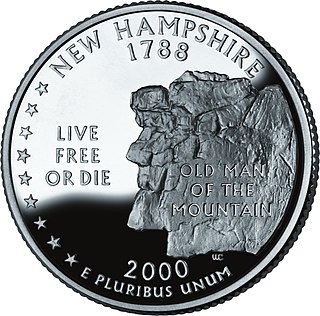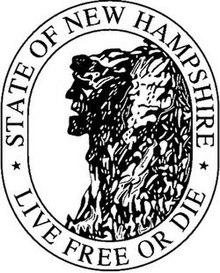
The State Emblem of India is the national emblem of the Republic of India and is used by the union government, many state governments, and other government agencies. The emblem is an adaptation of the Lion Capital of Ashoka, an ancient sculpture dating back to 280 BCE during the Maurya Empire. The statue is a three dimensional emblem showing four lions. It became the emblem of the Dominion of India in December 1947, and later the emblem of the Republic of India. The State Emblem of India is an official seal of the Government of India. It is used as the national emblem of India and appears on official documents, currency and passports.

"Live Free or Die" is the official motto of the U.S. state of New Hampshire, adopted by the state in 1945. It is possibly the best-known of all state mottos, partly because it conveys an assertive independence historically found in American political philosophy and partly because of its contrast to the milder sentiments found in other state mottos.

"In God We Trust" is the official motto of the United States as well as the motto of the U.S. state of Florida, along with the nation of Nicaragua. It was adopted by the U.S. Congress in 1956, replacing E pluribus unum, which had been the de facto motto since the initial design of the Great Seal of the United States.

E pluribus unum – Latin for "Out of many, one" – is a traditional motto of the United States, appearing on the Great Seal along with Annuit cœptis and Novus ordo seclorum which appear on the reverse of the Great Seal; its inclusion on the seal was suggested by Pierre Eugene du Simitiere and approved in an act of the Congress of the Confederation in 1782. While its status as national motto was for many years unofficial, E pluribus unum was still considered the de facto motto of the United States from its early history. Eventually, the U.S. Congress passed an act in 1956, adopting "In God We Trust" as the official motto.

The U.S. state of New Hampshire has held two seals since it declared its independence from Great Britain on January 5, 1776. While both seals have been retained, most people are only familiar with the Great Seal due to its corporate use.

Satyameva Jayate is a part of a mantra from the Hindu scripture Mundaka Upanishad. Following the independence of India, it was adopted as the national motto of India on 26 January 1950, the day India became a republic. It is inscribed in the Devanagari script at the base of the Lion Capital of Ashoka and forms an integral, part of the Indian national emblem. The emblem and the words "Satyameva Jayate" are inscribed on one side of all Indian currency and national documents.
Title I: The State and Its Government, is the collection of New Hampshire Revised Statutes Annotated which relate to the state's government as a whole. Like other portions of the RSAs, the Title is divided into Chapters and Sections organized in numbers and subsections organized in lowercase letters.

The emblem of the Kirghiz Soviet Socialist Republic was adopted on 23 March 1937 by the government of the Kirghiz Soviet Socialist Republic. The coat of arms is based on the coat of arms of the Soviet Union. It shows symbols of agriculture on a backdrop of the Ala-Too mountain ranges, surrounded by a frame of folk art of the Kyrgyz people. The red star was added in 1948. The rising sun stands for the future of the Kyrgyz nation, the star as well as the hammer and sickle for the victory of communism and the "worldwide socialist community of states".

The Emblem of the Uzbek Soviet Socialist Republic was adopted on 14 February 1937 by the government of the Uzbek Soviet Socialist Republic. The emblem is based on the emblem of the Soviet Union. It shows symbols of agriculture and heavy industry (hammer). The rising sun over a map of the Soviet Central Asia symbolizes the future of this region, while the five pointed red star stands for the "socialist revolution on all five continents".

Burnie City Council is a local government body in Tasmania, located in the city and surrounds of Burnie in the north-west of the state. The Burnie local government area is classified as urban and has a population of 19,348, which also encompasses Cooee, Hampshire, Natone and Ridgley.
Wooley v. Maynard, 430 U.S. 705 (1977), was a case in which the Supreme Court of the United States held that New Hampshire could not constitutionally require citizens to display the state motto upon their license plates when the state motto was offensive to their moral convictions.
The flag and the coat of arms of Terengganu are state symbols of Terengganu, a state in Malaysia. Like the majority of state symbols for states with Malay royalties, the flag and the arms of Terengganu centre on its royalty, as well as Islam, the state's traditional religion.

The Emblem of the Russian Soviet Federative Socialist Republic was adopted on 10 July 1918 by the Government of the Soviet Union, and had been modified several times afterwards. It shows wheat as the symbol of agriculture, a rising sun to symbolize the republic's future, the red star as well as the hammer and sickle for the victory of communism and the "world-wide socialist community of states".









